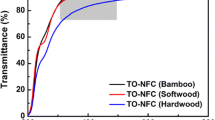Abstract
Bleached bamboo kraft pulp was pretreated by 2,2,6,6-tetramethylpiperidine-1-oxy radical (TEMPO)- mediated oxidation using a TEMPO/NaBr/NaClO system at pH = 10 in water to facilitate mechanical disintegration into TEMPO-oxidized cellulose nanofibrils (TO-CNs). A series of TO-CNs with different carboxylate contents were obtained by varying amounts of added NaClO. An increase in carboxylate contents results in aqueous TO-CN dispersions with higher yield, zeta potential values, and optical transparency. When carboxylate groups are introduced, the DPv value of the TO-CNs remarkably decreases and then levels off. And the presence of hemicellulose in the pulp is favorable to TEMPO oxidization. After the oxidization, the native cellulose I crystalline structure and crystal size of bamboo pulp are almost maintained. TEM micrographs revealed that the degree of nanofibrillation is directly proportional to the carboxylate contents. With increasing carboxylate contents, the free-standing TO-CN films becomes more transparent and mechanically stronger. The oxygen permeability of PLA films drastically decreases from 355 for neat PLA to 8.4 mL∙m–2∙d–1 after coating a thin layer of TO-CN with a carboxylate content of 1.8 mmol∙g–1. Therefore, inexpensive and abundant bamboo pulp would be a promising starting material to isolate cellulose nanfibrils for oxygen-barrier applications.

Similar content being viewed by others
References
Siró I, Plackett D. Microfibrillated cellulose and new nanocomposite materials: A review. Cellulose (London, England), 2010, 17(3): 459–494
Kalia S, Boufi S, Celli A, Kango S. Nanofibrillated cellulose: Surface modification and potential applications. Colloid & Polymer Science, 2014, 292(1): 5–31
Dieter K, Friederike K, Sebastian M, Tom L M, Mikael A, Derek G. Nanocelluloses: A new family of nature-based materials. Angewandte Chemie International Edition, 2011, 50(24): 5438–5466
Dufresne A. Nanocellulose: A new ageless bionanomaterial. Materials Today, 2013, 16(6): 220–227
Isogai A, Saito T, Fukuzumi H. TEMPO-oxidized cellulose nanofibers. Nanoscale, 2011, 3(1): 71–85
Khalil H P S A, Davoudpour Y, Islam M N, Mustapha A, Sudesh K, Dungani R, Jawaid M. Production and modification of nanofibrillated cellulose using various mechanical processes: A review. Carbohydrate Polymers, 2014, 99: 649–665
Besbes I, Alila S, Boufi S. Nanofibrillated cellulose from TEMPOoxidized eucalyptus fibres: Effect of the carboxyl content. Carbohydrate Polymers, 2011, 84(3): 975–983
Tsuguyuki S, Yoshiharu N, Jean-Luc P, Michel V, Akira I. Homogeneous suspensions of individualized microfibrils from TEMPO-catalyzed oxidation of native cellulose. Biomacromolecules, 2006, 7(6): 1687–1691
Saito T, Kimura S, Nishiyama Y, Isogai A. Cellulose nanofibers prepared by TEMPO-mediated oxidation of native cellulose. Biomacromolecules, 2007, 8(8): 2485–2491
Puangsin B, Fujisawa S, Kuramae R, Saito T, Isogai A. TEMPOmediated oxidation of hemp bast holocellulose to prepare cellulose nanofibrils dispersed in water. Journal of Polymers and the Environment, 2013, 21(2): 555–563
Rodionova G, Saito T, Lenes M, Eriksen Ø, Gregersen Ø, Fukuzumi H, Isogai A. Mechanical and oxygen barrier properties of films prepared from fibrillated dispersions of TEMPO-oxidized Norway spruce and Eucalyptus pulps. Cellulose (London, England), 2012, 19(3): 705–711
Puangsin B, Yang Q, Saito T, Isogai A. Comparative characterization of TEMPO-oxidized cellulose nanofibril films prepared from non-wood resources. International Journal of Biological Macromolecules, 2013, 59: 208–213
Sehaqui H, Zhou Q, Ikkala O, Berglund L A. Strong and tough cellulose nanopaper with high specific surface area and porosity. Biomacromolecules, 2011, 12(10): 3638–3644
Montanari S, Roumani M, Heux L, Vignon M R. Topochemistry of carboxylated cellulose nanocrystals resulting from TEMPOmediated oxidation. Macromolecules, 2005, 38(5): 1665–1671
Wang H, Zhang X, Jiang Z, Li W, Yu Y. A comparison study on the preparation of nanocellulose fibrils from fibers and parenchymal cells in bamboo (Phyllostachys pubescens). Industrial Crops and Products, 2015, 71: 80–88
Saito T, Isogai A. The effect of oxidation conditions on chemical and crystal structures of the water-insoluble fractions. Biomacromolecules, 2004, 5(5): 1983–1989
Smith D K, Bampton R F, Alexander W J. Use of new solvents for evaluating chemical cellulose for the viscose process. Industrial & Engineering Chemistry Process Design and Development, 1963, 2 (1): 57–62
Segal L, Creely J, Martin A Jr, Conrad C. An empirical method for estimating the degree of crystallinity of native cellulose using the X-ray diffractometer. Textile Research Journal, 1959, 29(10): 786–794
Scherrer P. Estimation of the size and internal structure of colloidal particles by means of röntgen. Nachr. Ges.Wiss. Gottingen, 1918, 2: 98–112
Jiang F, Esker A R, Roman M. Acid-catalyzed and solvolytic desulfation of H2SO4-hydrolyzed cellulose nanocrystals. Langmuir, 2010, 26(23): 17919–17925
Shinoda R, Saito T, Okita Y, Isogai A. Relationship between length and degree of polymerization of TEMPO-oxidized cellulose nanofibrils. Biomacromolecules, 2012, 13(3): 842–849
Jiang F, Hsieh Y L. Chemically and mechanically isolated nanocellulose and their self-assembled structures. Carbohydrate Polymers, 2013, 95(1): 32–40
Fukuzumi H, Saito T, Okita Y, Isogai A. Thermal stabilization of TEMPO-oxidized cellulose. Polymer Degradation & Stability, 2010, 95(9): 1502–1508
Da Silva Perez D, Montanari S, Vignon M R. TEMPO-mediated oxidation of cellulose III. Biomacromolecules, 2003, 4(5): 1417–1425
Isogai T, Saito T, Isogai A. Wood cellulose nanofibrils prepared by TEMPO electro-mediated oxidation. Cellulose (London, England), 2011, 18(2): 421–431
Fukuzumi H, Saito T, Iwata T, Kumamoto Y, Isogai A. Transparent and high gas barrier films of cellulose nanofibers prepared by TEMPO-mediated oxidation. Biomacromolecules, 2008, 10(1): 162–165
Henriksson M, Berglund L A, Isaksson P, Lindström T, Nishino T. Cellulose nanopaper structures of high toughness. Biomacromolecules, 2008, 9(6): 1579–1585
Acknowledgements
The authors are grateful for the financial supports from the Public Welfare Projects of Zhejiang Province (No. 2016C33029 & 2017C33113), the National Natural Science Foundation of China (Grant No. 21404092), and Scientific Research Foundation of Zhejiang Agricultural & Forestry University (No. 2013FR088).
Author information
Authors and Affiliations
Corresponding authors
Rights and permissions
About this article
Cite this article
Wu, B., Geng, B., Chen, Y. et al. Preparation and characteristics of TEMPO-oxidized cellulose nanofibrils from bamboo pulp and their oxygen-barrier application in PLA films. Front. Chem. Sci. Eng. 11, 554–563 (2017). https://doi.org/10.1007/s11705-017-1673-8
Received:
Accepted:
Published:
Issue Date:
DOI: https://doi.org/10.1007/s11705-017-1673-8




